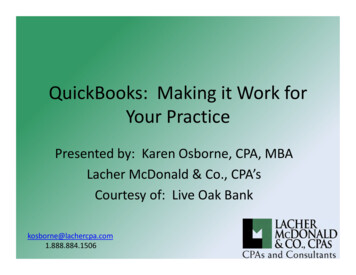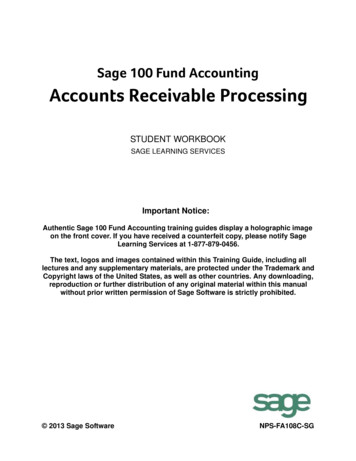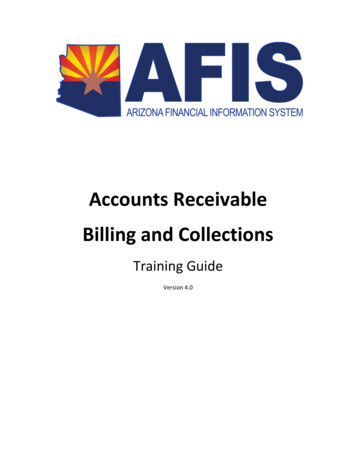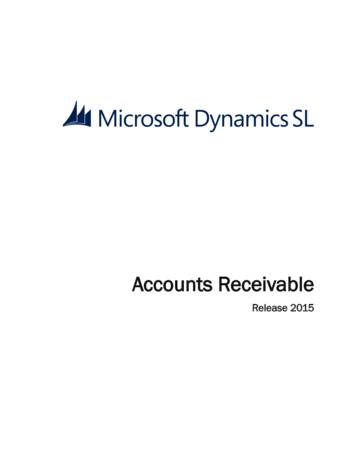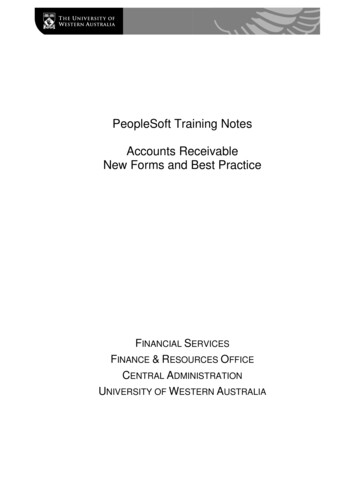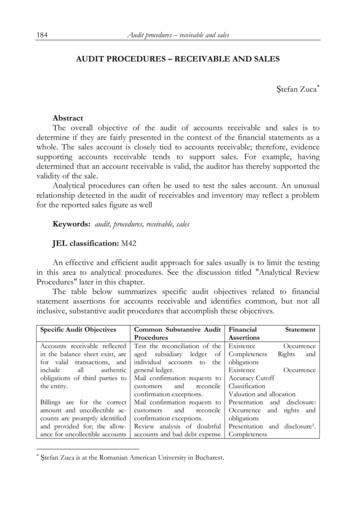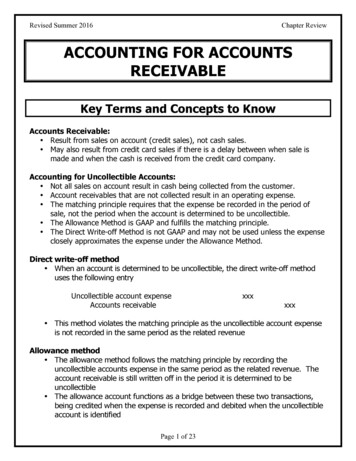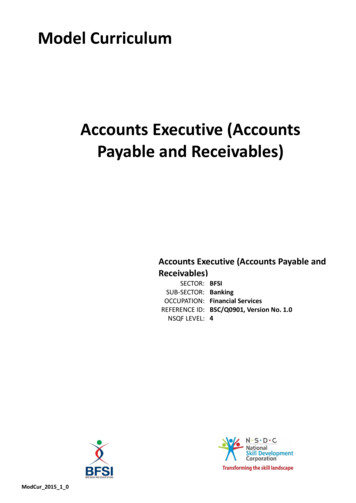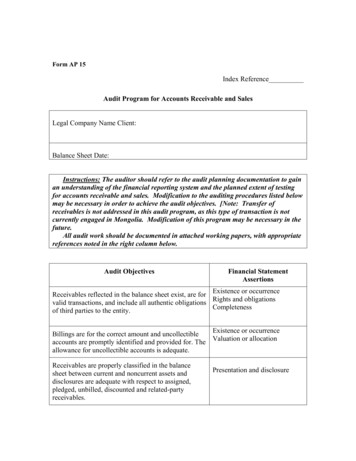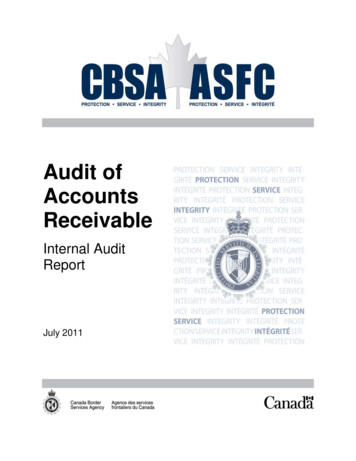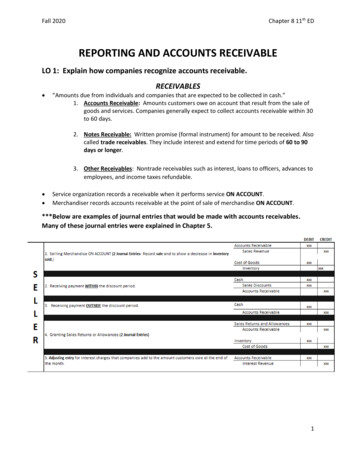
Transcription
Chapter 8 11th EDFall 2020REPORTING AND ACCOUNTS RECEIVABLELO 1: Explain how companies recognize accounts receivable.RECEIVABLES “Amounts due from individuals and companies that are expected to be collected in cash.”1. Accounts Receivable: Amounts customers owe on account that result from the sale ofgoods and services. Companies generally expect to collect accounts receivable within 30to 60 days.2. Notes Receivable: Written promise (formal instrument) for amount to be received. Alsocalled trade receivables. They include interest and extend for time periods of 60 to 90days or longer.3. Other Receivables: Nontrade receivables such as interest, loans to officers, advances toemployees, and income taxes refundable. Service organization records a receivable when it performs service ON ACCOUNT.Merchandiser records accounts receivable at the point of sale of merchandise ON ACCOUNT.***Below are examples of journal entries that would be made with accounts receivables.Many of these journal entries were explained in Chapter 5.1
Chapter 8 11th EDFall 2020Example: Prepare journal entries to record the following transactions entered into by the CastagnoCompany:Nov.Nov.Nov.159Sold merchandise on account to Mercer, Inc., for 18,000, terms 2/10, n/30.Mercer, Inc., returned merchandise worth 1,000.Received payment in full from Mercer, Inc.Accounts Receivable- Mercer, Inc.Sales RevenueDateNov. 1Debit18,000Credit18,000Sales Returns and AllowancesAccounts Receivable- Mercer, Inc.Nov. 5CashSales Discounts ( 17,000 x 0.02)Accounts Receivable- Mercer, Inc.Nov. 91,0001,00016,66034017,000***Remember: 2/10, n/30 means that the buyer (Mercer) will get a 2% discounton the selling price if they pay Castagno within 10 days, otherwise the fullamount is due in 30 days with no discount.2
Chapter 8 11th EDFall 2020LO 2: Describe how companies value accounts receivable and record theirdisposition.VALUING ACCOUNTS RECEIVABLE Current asset on the balance sheet.Valuation (net realizable value). (The amount of accounts receivable that the company actuallyexpects to collect.)Bad Debt Expense: Losses that the seller records as a result from extending credit and not beingable to collect the money.Two methods used in accounting for uncollectible accounts are:1. Direct Write-Off Method Records bad debt expense only when an account is determined to be worthless. Used by SMALL companies and companies with a FEW receivables. No matching. Receivable is not stated at net realizable value. Not acceptable for financial reporting. If an accounts receivable that has been written off is later collected, then 2 journalentries have to be made. One to reinstate the accounts receivable and the other oneto collect the cash.2. Allowance Method Records bad debt expense by estimating uncollectible accounts at the end of theaccounting period. Generally accepted accounting principles (GAAP) require companies with a largeamount of receivables to use the allowance method. When an estimation of bad debts is made the account “ALLOWANCE FORDOUBTFUL ACCOUNTS” gets credited (Has a normal CREDIT balance after the endof period adjusting journal entry). It is a contra-asset.o Allowance for Doubtful accounts has a DEBIT balance when:the write-offs during the period EXCEED than the beginning balance.o Allowance for Doubtful accounts has a CREDIT balance when:write-offs during the period are LESS than the beginning balance.Cash (Net) Realizable Value of Receivables Accounts Receivable Balance – Allowance for Doubtful Accounts3
Chapter 8 11th EDFall 2020Example: On November 15, it was determined that Mr. Sanders account of 3,000 would beuncollectible. On December 20, after Mr. Sanders account was written off he paid Company M 3,000 infull. On December 31, Company M estimated that 10,000 of their remaining credit sales will proveuncollectible.a) Prepare the journal entries for November 15, December 20, and December 31 under the direct writeoff method.Bad Debt ExpenseAccounts Receivable- Mr. SandersDateNov. 15Debit3,0003,000Accounts Receivable- Mr. SandersBad Debt ExpenseDec. 20CashDec. 203,0001,0003,000Accounts Receivable- Mr. SandersNO JOURNAL ENTRYCredit3,000Dec. 31b) Prepare the journal entries for November 15, December 20, and December 31 under the allowancemethod.Allowance for Doubtful AccountsAccounts Receivable- Mr. SandersDateNov. 15Debit3,0003,000Accounts Receivable- Mr. SandersAllowance for Doubtful AccountsDec. 20CashDec. 203,0001,0003,000Accounts Receivable- Mr. SandersBad Debt ExpenseAllowance for Doubtful AccountsCredit3,000Dec. 3110,00010,0004
Fall 2020Chapter 8 11th EDPRESENTATION OF ACCOUNTS RECIEVABLE ON THE BALANCE SHEET UNDER THEALLOWANCE METHOD Cash (Net) Realizable Value Accounts Receivable – Allowance for Doubtful AccountsFor Hampson Furniture, of the 200,000 in Accounts Receivable, they only expect to collect 188,000. They do not expect to collect 12,000.5
Chapter 8 11th EDFall 20202 Methods for Estimating Uncollectible Accounts under the Allowance Method1. Balance Sheet Approach (Percent of Ending Accounts Receivable Method)Allowance for Doubtful Accounts% of End Accounts Receivable as Uncollectible as a decimal x End A/R BEG Balance*X--- WE NEED TOFIGURE THEADJUSTMENT FROMTHE BEG TO ENDBALANCEJOURNAL ENTRYBad Debt ExpenseXAllowance for Doubtful AccountsXY- END BALANCERULES1. IF BEGINNING ALLOWANCE FOR DOUBTFUL ACCOUNTS IS A CREDIT THENEND BALANCE – BEGINNING BALANCE X2. IF BEGINNING ALLOWANCE FOR DOUBTFUL ACCOUNTS IS A DEBIT THENEND BALANCE BEGINNING BALANCE XEx: 1 Smith Inc. estimates that 1% of their 100,000 accounts receivable balance as of December31 will be uncollectible. What Journal entry would be made on December 31 if the beginningbalance for the Allowance for Doubtful Accounts was a 600 CREDIT balance?400Bad Debt ExpenseAllowance for Doubtful Accounts400 1,000 (END) - 600 (BEG) 1,000 (END) - 600 (BEG)Allowance for Doubtful Accounts 600 Beginning Balance 400 1,000 1,000 (END) - 600 (BEG) 4000.01 X 100,000 1,000Ending Balance6Y
Chapter 8 11th EDFall 2020Ex: 2 Smith Inc. estimates that 1% of their 100,000 accounts receivable balance as of December31 will be uncollectible. What Journal entry would be made on December 31 if the beginningbalance for the Allowance for Doubtful Accounts was a 600 DEBIT balance?1,600Bad Debt Expense 1,000 (END) 600 (BEG) 1,000 (END) 600 (BEG)1,600Allowance for Doubtful AccountsAllowance for Doubtful AccountsBEG: 600 1,600 1,000 (END) 600 (BEG) 1,600End: 1,0000.01 X 100,000 1,0002. Balance Sheet Approach (Aging the Accounts Receivables Method)TotalsAging ofRecievablesMethodJohn SmithSueJimTotal RecievablesPercent Uncollectible 2,000 3,000 10,000 15,000ESTIMATED UNCOLLECTIBLE 1,820.00Not Yet Due 1-30 days Past Due 31-60 days Past Due 61-90 days Past Due 90 Days Past Due 1,000 1,000 1,000 1,000 1,000 5,000 2,000 1,000 2,000 6,000 2,000 3,000 2,000 2,0002%5%10%25%40% 120 100 300 500 800Ending Balance of Allowance for Doubtful Accounts*If Allowance for Doubtful Accounts had an unadjusted 500 credit balance then .Ending Balance – Beginning Balance Adjustment 1,820 - 500 1,320Bad Debt Expense1,320Allowance for Doubtful Accounts1,320*The amount of the adjusting entry is the amount that will yield an adjusted balance forAllowance for Doubtful Accounts equal to that estimated by the aging schedule. In this case theadjusted entry which CREDITS Allowance for Doubtful Accounts by 1,320 leads to the endingadjusted balance of the Allowance for Doubtful Accounts to have a CREDIT balance of 1,820.7
Chapter 8 11th EDFall 2020DISPOSING OF ACCOUNTS RECEIVABLESale of Receivables to a Factor A factor is a finance company or bank.o Buys receivables from businesses and then collects the payments directly from thecustomers.o Typically charges a commission to the company that is selling the receivables.o Fee ranges from 1% to 3% of the receivables purchased.Ex: Assume that Hendredon Furniture factors 600,000 of receivables to Federal Factors on Nov. 15.Federal Factors assesses a service charge of 2% of the amount of receivables sold. The journal entry torecord the sale by Hendredon Furniture is as follows:CashService Charge Expense ( 600,000 x 2%)Accounts ReceivableDateNov. 15Debit588,00012,000Credit600,000National Credit Card Sales (Customers that use Visa, Mastercard, or other credit card) A retailer’s acceptance of a national credit card is another form of selling (factoring) the receivablesby the retailer.o Retailer pays card issuer a fee of 2 to 4% of the invoice price for its services.o Recorded the same as cash sales.oAdvantages to retailer: Issuer does credit investigation of customer. Issuer maintains customer accounts. Issuer undertakes collection and absorbs losses. Receives cash more quickly.Ex: Chef Louie purchases 2,000 worth of food and ingredients for his restaurant from Frank’s FreshMarket store, and he charges this amount on his MasterCard. The service fee that MasterCard chargesFrank’s Fresh Market is 4%. Frank’s Fresh Market would record this transaction on March 28 as follows:CashService Charge Expense ( 2,000 x 4%)Sales RevenueDateMar. 28Debit1,92080Credit2,0008
Chapter 8 11th EDFall 2020LO 3: Explain how companies recognize, value, and dispose of Notes Receivable.Promissory Note: “written promise to pay a specified amount of money on demand or at a definitetime.” Promissory notes may be used when1. Individuals and companies lend or borrow money.2. Amount of transaction and credit period exceed normal limits.3. In settlement of accounts receivable. Used for a credit period of more than 60 days. If it is going to be collected WITHIN ONE YEAR, it isclassified as a current asset on the balance sheet. If it is going to be collected AFTER MORE THAN AYEAR, then it is classified as a noncurrent asset as an investment on the balance sheet. Report short-term notes receivable at their cash (net) realizable value. Estimation of cash realizable value and recording bad debt expense and related allowance aresimilar to accounts receivable.EXAMPLE used for terms below: A NOTE DATED JUNE 20, 20XX FOR RON TO PAY CAM 1,000 ONOCTOBER 20, 20XX WITH AN INTEREST RATE OF 10%.1. Face Value of a Note (Principal): specified amount of money at a definite future date.(Ex: 1,000)2. Maker of the Note: the person who signed the note and promised to pay it at maturity. (Ex: RON) The maker of the note recognizes a note payable.3. Payee of the Note: the person to whom the note is payable. (Ex: CAM) The payee of the note recognizes a note receivable.4. Issuance Date: the date the note is issued. (Ex: JUNE 20, 20XX)5. Maturity date of the Note: the date the note must be repaid. (Ex: OCTOBER 20, 20XX) May be stated on demand, on a stated date, or at the end of a stated period of time. Note terms are expressed in months and days.*When months or years are used, the note matures and is payable in the month of its maturity on thesame day of the month as its original date. For example, a 9-month note dated September 28 would bepayable on June 28.*If days, then have to count days in the month. DON’T INCLUDE DATE OF NOTE AS PART OF NUMBER OFDAYS. For example, if note issued March 16 the amount of days note is outstanding inMarch is 31 days – 16 15 days.Term of NoteMarch (31-16) 15 daysApril30 daysMay31 daysJune(Maturity Date)90 days76149
Fall 2020Chapter 8 11th ED6. Term of Note: amount of time between the issuance and due dates. (About 122 days—Timebetween June 20, 20XX and October 20, 20XX)7. Interest Computation:Time in Terms of One YearDays: # of days 360Months: # of months 12Years: # of years 1Ex: The total interest for a 1,000, 90-day, and 10% note would be computed as follows: 1,000 X 10% X (90/360) 25Current Example: 122 day note between Ron and Cam. 1,000 x 10% x (122/360) 33.89 Interest8. Maturity Value: Amount that must be paid at the due date of the note. It is the sum of theface amount and interest. In our example Ron has to pay Cam 1,033.89 ( 1,000 Face Amount 33.89 Interest) when note is due on October 20, 2017.Another Note Examplewith Terms10
Chapter 8 11th EDFall 2020Journal Entries for Notes Receivable1. Recognizing Notes Receivable (Tropical Breeze-Payee point of view)Tropical Breeze Inc. received a 2,000, 90-day, 10% promissory note from Paradise Sand to settle theiroverdue open account.2. Recording an Honored Note (Tropical Breeze-Payee point of view)After 90 days, Tropical Breeze Inc. receives 2,050 from Paradise Sand ( 2,000 to repay the note and 50 in interest.) Interest (2,000 x 10% x (90/360)) 503. Recording a Dishonored Note (Tropical Breeze-Payee point of view)After 90 days, Paradise Sand is unable and refuses to pay Tropical Breeze Inc. 2,050 ( 2,000 to repaythe note and 50 in interest.)4. Recording End-of-Period Interest Adjustment (Tropical Breeze-Payee point of view)If Tropical Breeze Inc. receives a 2,000, 90-day, 10% promissory note from Paradise Sand onDecember 1, then on December 31 Tropical Breeze Inc. would need to recognize 30 days of interest. 2,000 X 10% X (30/360) 16.6711
Chapter 8 11th EDFall 2020LO 4: Describe the statement presentation of receivables and the principles ofreceivables management. Companies need to identify in the balance sheet or in notes to the financial statements each of themajor types of receivables.Companies report both the gross amount of receivables and the allowance for doubtful accounts.MANAGING RECEIVABLESManaging accounts receivable involves five steps:1. Determine to whom to extend credit.2. Establish a payment period.3. Monitor collections. Companies should prepare an accounts receivable aging schedule at least monthly. Helps managers estimate the timing of future cash inflows. Provides information about the collection experience of the company andidentifies problem accounts.4. Evaluate the liquidity of receivables. Accounts Receivable Turnover: Measure the number of times, on average, acompany collects receivables during the period. Average Collection Period: Used to assess the effectiveness of credit and collectionpolices. This period SHOULD NOT EXCEED credit term period.5. Accelerate cash receipts from receivables when necessary.12
Sale of Receivables to a Factor A factor is a finance company or bank. o Buys receivables from businesses and then collects the payments directly from the customers. o Typically charges a commission to the company that is selling the receivables. o Fee ranges from 1% to 3% of the receivables purchased.

